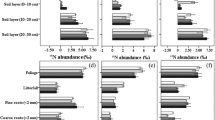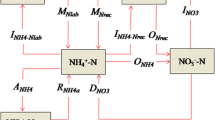Abstract
Purpose
This study examined the usefulness of 15N natural abundance (δ15N) with in situ core incubation to quantify the predominant N transformation processes in a natural suburban forest of subtropical Australia, which was subjected to prescribed burning.
Materials and methods
In situ core incubation for 3 days with 20 ml water, or 160.79 ml of 60 mg L−1 NO3−-N surface application, and in situ core with 160.79 ml water but without incubation were set up in Toohey forest for sampling three times as before (once) and after (twice) a prescribed burning. The δ15N of NH4+-N and NO3−-N in the top 5 cm soil before and after the incubation, and δ15N of NO3−-N in the 5–10 cm soil before incubation were compared with each other to examine the soil N mineralisation, nitrification, denitrification, and nitrate leaching processes.
Results and discussion
The significant decrease in δ15N of NH4+-N after incubation under 20 ml water treatment was ascribed to soil N mineralisation, and the significant decrease in δ15N of NH4+-N and significant increase in δ15N of NO3−-N after incubation with elevated water and nitrate inputs were associated with N mineralisation and nitrification, respectively, 2 months after the burning. The 160.79 ml water treatment also triggered nitrification in the baseline soil cores in both samplings after the burning. Water was crucial to stimulate soil N mineralisation and nitrification, but excessive water depleted labile N pools and reduced N mineralisation and nitrification. Burning effects were hard to separate from the seasonal impacts on soil N cycling processes.
Conclusions
The δ15N in soil mineral N pools was sensitive to indicate soil N mineralisation and nitrification processes. Soil water and labile N were determining factors for N transformations in the soil. It is suggested that δ15N combined with soil inorganic N concentrations and net N transformation rates could be used to identify primary N transformation processes. More frequent samplings would be needed to differentiate burning impacts from the seasonal impacts on soil N cycling processes.





Similar content being viewed by others
References
Barraclough D (1995) 15N isotope dilution techniques to study soil nitrogen transformations and plant uptake. Nutr Cycl Agroecosyst 42:185–192
Bauhus J, Khanna PK, Raison RJ (1993) The effect of fire on carbon and nitrogen mineralization and nitrification in an australian forest soil. Aust J Soil Res 31:621–639
Bengtson P (2004) Microbial mobilization and immobilization of soil nitrogen. Dissertation, Lund University
Boerner REJ, Brinkman JA (2006) Effects of prescribed fire at two frequencies on N mineralization and nitrification at two spatial scales in mixed-oak forests. Fire Ecol 1:28–49
Boerner REJ, Giai C, Huang J, Miesel JR (2008) Initial effects of fire and mechanical thinning on soil enzyme activity and nitrogen transformations in eight North American forest ecosystems. Soil Biol Biochem 40:3076–3085
Catterall CP, Wallace CP (1987) An island in suburbia: the natural and social history of Toohey Forest. Institute of Applied Environmental Research, Griffith University, Brisbane
Catterall CP, Piper SD, Bunn SE, Arthur JM (2001) Flora and fauna assemblages vary with local topography in a subtropical eucalypt forest. Austral Ecol 26:56–69
Choi WJ, Kwak JH, Lim SS, Park HJ, Chang SX, Lee SM, Arshad MA, Yun SI, Kim HY (2017) Synthetic fertilizer and livestock manure differently affect δ15N in the agricultural landscape: a review. Agric Ecosyst Environ 237:1–15
Conen F, Yakutin MV, Puchnin AN, Leifeld J, Alewell C (2011) ∂15N natural abundance in permafrost soil indicates impact of fire on nitrogen cycle. Rapid Commun Mass Spectrom 25:661–664
Covington WW, Sackett SS (1992) Soil mineral nitrogen changes following prescribed burning in ponderosa pine. For Ecol Manag 54:175–191
Denk TRA, Mohn J, Decock C, Lewicka-Szczebak D, Harris E, Butterbach-Bahl K, Kiese R, Wolf B (2017) The nitrogen cycle: a review of isotope effects and isotope modeling approaches. Soil Biol Biochem 105:121–137
Gómez-Rey MX, González-Prieto SJ (2015) Soil gross N transformation rates after a wildfire and straw mulch application for burned soil emergency stabilisation. Biol Fertil Soils 51:493–505
Hart SC, Stark JM, Davidson EA, Firestone MK (1994) Nitrogen mineralization, immobilization, and nitrification. In: Bigham JM (ed) Methods of soil analysis: part 2 microbiological and biochemical properties. Soil Science Society of America, pp 985–1018
Hobbie EA, Macko SA, Shugart HH (1999) Interpretation of nitrogen isotope signatures using the NIFTE model. Oecologia 120:405–415
Houlton BZ, Marklein AR, Bai E (2015) Representation of nitrogen in climate change forecasts. Nat Clim Chang 5:398–401
Jones AR, Dalal RC (2017) Enrichment of natural 15N abundance during soil N losses under 20 years of continuous cereal cropping. Sci Total Environ 574:282–287
Koyama A, Kavanagh KL, Stephan K (2010) Wildfire effects on soil gross nitrogen transformation rates in coniferous forests of Central Idaho, USA. Ecosystems 13:1112–1126
Minet E, Coxon CE, Goodhue R, Richards KG, Kalin RM, Meier-Augenstein W (2012) Evaluating the utility of 15N and 18O isotope abundance analyses to identify nitrate sources: a soil zone study. Water Res 46:3723–3736
Moghaddas EEY, Stephens SL (2007) Thinning, burning, and thin-burn fuel treatment effects on soil properties in a Sierra Nevada mixed-conifer forest. For Ecol Manag 250:156–166
Murphy DV, Recous S, Stockdale EA, Fillery IRP, Jensen LS, Hatch DJ, Goulding KWT (2003) Gross nitrogen fluxes in soil theory measurement and application of 15N pool dilution techniques. Adv Agron 79:69–118
Pörtl K, Zechmeister-Boltenstern S, Wanek W, Ambus P, Berger TW (2007) Natural 15N abundance of soil N pools and N2O reflect the nitrogen dynamics of forest soils. Plant Soil 295:79–94
Raison RJ, Connel MJ, Khanna PK (1987) Methodology for studying fluxes of soil minera-N in situ. Soil Biol Biochem 19:521–530
R Core Team (2018) R: A language and environment for statistical computing. R Foundation for Statistical Computing, Vienna
Rennenberg H, Dannenmann M, Gessler A, Kreuzwieser J, Simon J, Papen H (2009) Nitrogen balance in forest soils: nutritional limitation of plants under climate change stresses. Plant Biol 11:4–23
Stephan K, Kavanagh KL, Koyama A (2015) Comparing the influence of wildfire and prescribed burns on watershed nitrogen biogeochemistry using 15N natural abundance in terrestrial and aquatic ecosystem components. PLoS One 10:1–21
Turner MG, Smithwick EAH, Metzger KL, Tinker DB, Romme WH (2007) Inorganic nitrogen availability after severe stand-replacing fire in the greater Yellowstone ecosystem. Proc Natl Acad Sci 104:4782–4789
Wang Y, Xu Z, Zheng J, Abdullah KM, Zhou Q (2015) δ 15N of soil nitrogen pools and their dynamics under decomposing leaf litters in a suburban native forest subject to repeated prescribed burning in Southeast Queensland, Australia. J Soils Sediments 15:1063–1074
Wang A, Fang Y, Chen D, Phillips O, Koba K, Zhu W, Zhu J (2018) High nitrogen isotope fractionation of nitrate during denitrification in four forest soils and its implications for denitrification rate estimates. Sci Total Environ 633:1078–1088
Yahdjian L, Sala OE (2010) Size of precipitation pulses controls nitrogen transformation and losses in an arid Patagonian ecosystem. Ecosystems 13:575–585
Acknowledgements
This study was completed with the support of postgraduate research scholarships from Griffith University; special thanks to Professor Weijin Wang of Griffith University for his help with the sample analyses and critical opinions in shaping this paper; thank Geoffrey Lambert for his assistance with the field works.
Author information
Authors and Affiliations
Corresponding authors
Additional information
Responsible editor: Hailong Wang
Publisher’s note
Springer Nature remains neutral with regard to jurisdictional claims in published maps and institutional affiliations.
Rights and permissions
About this article
Cite this article
Wang, D., Xu, Z., Blumfield, T.J. et al. The potential of using 15N natural abundance in changing ammonium-N and nitrate-N pools for studying in situ soil N transformations. J Soils Sediments 20, 1323–1331 (2020). https://doi.org/10.1007/s11368-019-02478-1
Received:
Accepted:
Published:
Issue Date:
DOI: https://doi.org/10.1007/s11368-019-02478-1




